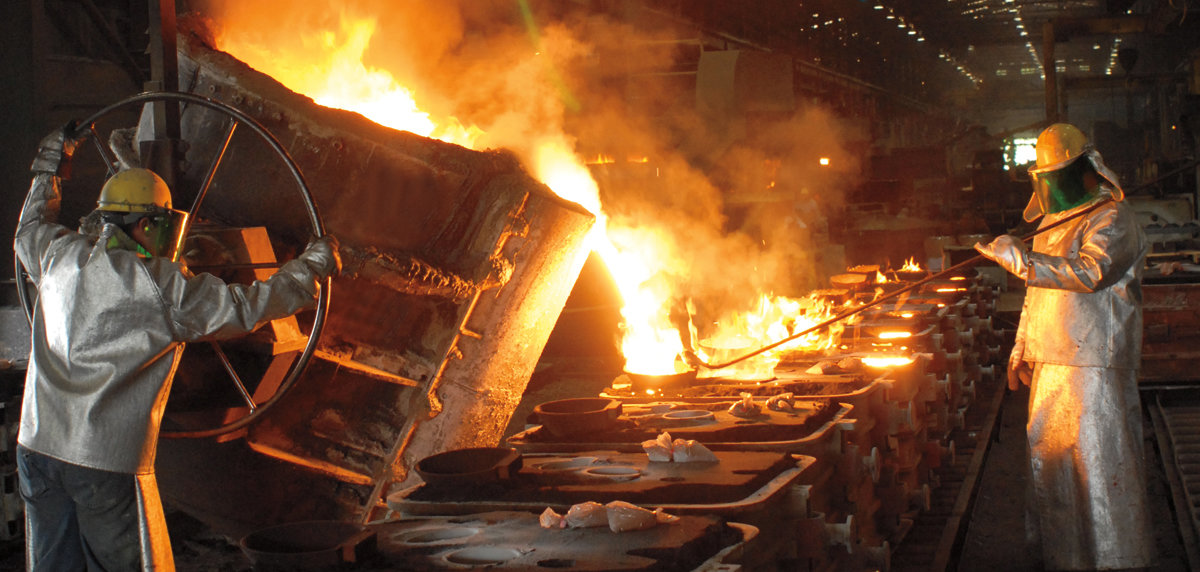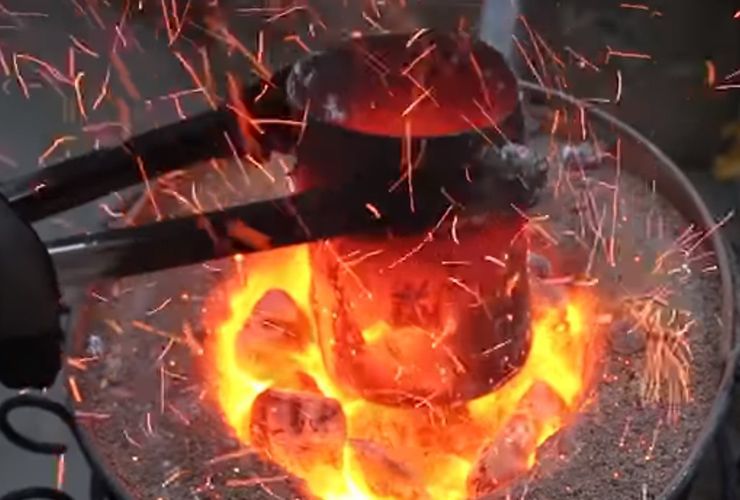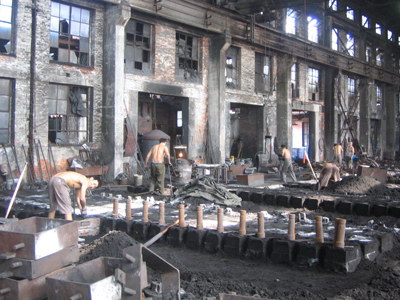Important distinctions between Metal Casting and other metal fabrication techniques
Discover the Ingenious Strategies Utilized in a Metal Foundry for Superior Casting Results
In today's affordable manufacturing landscape, metal foundries are increasingly embracing ingenious techniques to boost casting outcomes - Aluminum Foundry. Advanced computer system simulations enable accurate modeling of liquified metal behavior, while 3D printing makes it possible for quick production of intricate molds. Furthermore, green materials and automation streamline procedures. These growths assure substantial enhancements in efficiency and top quality control. However, the influence of these technologies on sustainability and manufacturing methods stays to be fully checked out
Advanced Computer System Simulations in Metal Casting
Advanced computer system simulations have transformed the metal casting process by enhancing precision and efficiency. These sophisticated tools allow designers to create virtual models of actors parts, allowing them to anticipate the habits and examine of liquified metal throughout the spreading stage. By imitating different parameters such as temperature level, circulation rate, and cooling rates, producers can determine prospective defects before physical production starts.
This proactive strategy lowers waste and minimizes costly mistakes, eventually resulting in improved item top quality. Additionally, simulations promote the optimization of mold and mildew layouts, ensuring that they fulfill the certain requirements of each project. The assimilation of computational fluid characteristics (CFD) and finite component evaluation (FEA) more adds to the precision of these simulations, providing understandings that were previously unattainable. As an outcome, advanced computer system simulations have become an essential element of modern metal foundries, substantially progressing the market's capacities.
3D Printing for Molds and Patterns
3D printing has arised as a groundbreaking technique for developing molds and patterns in the metal foundry market. This technology makes it possible for the quick production of complicated geometries that traditional manufacturing approaches struggle to achieve. By making use of additive manufacturing, foundries can produce detailed designs with minimized lead times and product waste. The capacity to produce molds as needed permits greater flexibility in design iterations, promoting faster prototyping and adjustments.
Moreover, 3D printing can use a variety of products, including plastics and steels, customized to details casting demands. This adaptability boosts the precision of molds, leading to exceptional spreading end results with enhanced surface finishes. Furthermore, the reduction in the number of parts needed simplifies assembly procedures, better maximizing manufacturing performance. As foundries remain to take on 3D printing, they are poised to redefine market requirements, leading the means for innovation and enhanced productivity in metal casting operations.
Eco-Friendly Materials and Processes
As the metal foundry industry faces increasing stress to minimize its environmental impact, the fostering of eco-friendly materials and procedures has ended up being crucial. Shops are currently discovering lasting options to standard products, such as utilizing bio-based binders and recycled metals. These materials not only lessen waste yet also reduced energy consumption throughout production.
Furthermore, improvements in sand casting techniques have actually caused making use of artificial sands that are less damaging to the atmosphere. Foundries are additionally applying cutting-edge procedures like molten metal treatment that lowers exhausts and enhances the quality of actors items.
Water-based coatings have replaced harmful solvents, advertising a more secure work atmosphere. By incorporating these environment-friendly techniques, metal foundries can considerably lower their eco-friendly effect while maintaining top notch casting results. This change not just profits the atmosphere however likewise lines up with the growing consumer need for lasting production services
Automation and Robotics in Foundry Procedures
While the metal foundry industry embraces development, the integration of automation and robotics is changing operations greatly. Automated systems enhance procedures such as mold making, metal pouring, and casting completing, substantially enhancing efficiency. Robotics help with the handling of heavy materials, minimizing the threat of office injuries and ensuring safer settings.

Better, the use of automated guided vehicles (AGVs) enhances product transport within centers, making sure prompt shipment of components to ideal workstations. By carrying out these technologies, Website foundries can adapt to changing needs with greater agility, inevitably bring about enhanced productivity and competition on the market. As automation and robotics proceed to progress, they hold the potential to redefine standard foundry practices and drive additional advancements in casting strategies.
Real-Time Tracking and Top Quality Control Techniques
The developments in automation and robotics have actually led the way for much more innovative strategies to quality control in metal foundries. Real-time surveillance systems utilize sophisticated sensing units and information analytics to track vital parameters throughout the spreading process. These systems constantly assess variables such as temperature, stress, and product composition, making it possible for immediate detection of inconsistencies from developed standards.
Quality control strategies currently incorporate artificial intelligence algorithms that evaluate historical information to forecast prospective flaws prior to they take place. This aggressive approach minimizes waste and improves general manufacturing performance. In addition, incorporated responses loopholes permit fast modifications, guaranteeing that each casting meets rigorous quality needs.
The application of digital twins-- virtual reproductions of physical possessions-- has likewise revolutionized top quality guarantee, permitting designers to simulate and optimize processes in real-time. With each other, these ingenious techniques greatly improve the reliability and top quality of castings, setting new market requirements in metal foundry procedures.
Regularly Asked Questions
What Types of Metals Are Commonly Cast in Shops?
Generally cast steels in foundries include aluminum, iron, bronze, and brass. Each metal displays special residential or commercial properties, making them ideal for different applications, such as automotive parts, equipment, and imaginative sculptures, improving their convenience in manufacturing.

How Lengthy Does the Casting Refine Generally Take?
The spreading process generally takes a number of hours to days, depending upon aspects such as the intricacy of the mold and mildew, sort of metal utilized, and air conditioning requirements. Each stage affects the overall period considerably.
What Safety Actions Are in Location for Foundry Workers?

How Are Defects in Castings Identified and Addressed?
Defects in castings are identified via visual assessments and non-destructive screening approaches. When discovered, foundry workers resolve them link by fine-tuning procedures, changing material make-ups, and executing corrective actions to guarantee top quality and conformity with criteria.
What Is the Expense Range for Metal Casting Providers?
The price variety for metal casting solutions typically varies in between $1 to $10 per extra pound, depending upon elements such as product type, intricacy of the layout, my sources and manufacturing volume, impacting total prices considerably.
In today's affordable manufacturing landscape, metal foundries are significantly taking on ingenious techniques to boost casting outcomes. As the metal foundry market encounters enhancing stress to reduce its ecological footprint, the adoption of green materials and procedures has actually come to be crucial. Shops are now discovering sustainable choices to typical materials, such as utilizing recycled metals and bio-based binders. By incorporating these environmentally friendly practices, metal foundries can substantially reduce their eco-friendly effect while keeping top quality spreading outcomes. The developments in automation and robotics have actually paved the means for much more sophisticated techniques to top quality assurance in metal foundries.